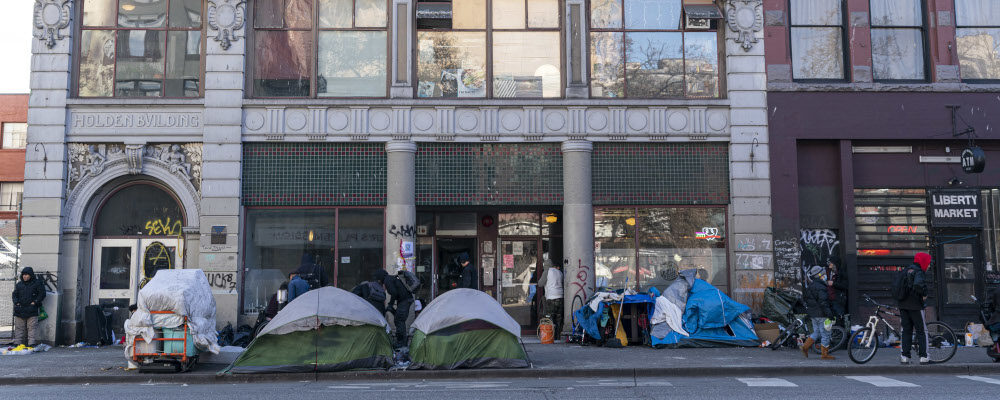Are you a NUMTOT? An ELMTOT? Or maybe an RRMTOT?
You might be one, even if you don’t know it yet. Those are, of course, fans of “New Urbanist Memes for Transit-Oriented Teens,” a global Facebook group of young urbanists; Expo Line Memes for similarly-oriented young people in BC’s Lower Mainland; and, not to be outdone, Rocket Riding Memes for teenage enthusiasts of Toronto and its TTC.
The popularity of such groups, together with social media channels like City Beautiful, Not Just Bikes, and r/f*ckcars, point to a particular interest among young Canadians in creating compact, walkable, and bikeable cities with better public transit and fewer cars. These “15-minute cities,” young urbanists argue, would be stronger communities with more dynamic economies, more fun, shorter commutes, and less of the pollution and habitat destruction caused by (sub)urban sprawl.
Canada has a particularly thriving online community of young urbanists. Despite our size, we’re largely an urban country: Three-quarters of Canadians live in cities and almost half (44 percent) of us are within a 20-minute drive of a downtown core. But the price of housing in our biggest cities has made urban life unaffordable. Moreover, under-built transportation systems are experiencing serious strains, and crime, street disorder, and vandalism are all on the rise. Meanwhile, our federal government and many municipal governments are led by left-of-centre politicians whose base of support is located in downtown cores and their urban fringes. No wonder there is a strong undercurrent of NUMTOT discontent with political leaders.
This represents an opportunity for collaboration between urbanists and conservatives. If right-leaning politicians learn to speak the urbanists’ language, they can appeal to younger voters and make inroads into cities. Likewise, if hardcore urbanists can speak to conservatives, they can make progress on their priorities even when the right is in power. Indeed, certain urbanist priorities are more likely to be advanced by conservatives than by progressives, simply because they don’t offend key points of today’s progressive thinking.
Rising crime provides the best example of this. Living in a compact, walkable neighbourhood and relying on walking, biking, or transit highlights the importance of safe streets. When you drive past encampments, open drug use, or unstable people acting out on the streets, you may be able to ignore the human tragedy and the threat to public safety that these situations represent. From your suburb, you can put a “In this house we believe” sign on your lawn and safely pat yourself on the back for your progressive luxury beliefs like hostility to the police, acceptance of public camping, and support for harm reduction as the only acceptable method of combating the addictions crisis.
But if you walk, bike, or take transit every day, the problems are impossible to ignore. Your daily commute reminds you that luxury beliefs are just that: a luxury you and your neighbours can’t afford. Ask ex-TTC riders, many of whom stopped riding the rocket in the face of increased threats to their safety, or the seniors and small business owners of Vancouver’s Chinatown, who are increasingly frustrated with the chaos of their neighbouring Downtown Eastside.
Across Canada, downtown residents were among the first to notice rising crime, and with good reason: those increases often start in the same neighbourhoods that have always been most marginal in our society, many of which are located in neglected areas near the urban core.
Granted, there are some downtowners who can afford such beliefs. They’re generally tall guys with Twitter accounts. They seem to not mind crime too much. They claim that everything is fine and being accosted by other tall guys — usually ones without Twitter accounts — en route to the grocery store is just a part of life that we should all just get used to.
But our shared vision of more compact and well-connected cities relies on the public actually wanting to live in such cities. If downtowns are known for crime and disorder, then most suburbanites will oppose making their neighbourhood anything more like downtown.
That’s where the potential for urbanist-conservative collaboration lies. The urban renaissance of the two last decades was prompted in part by decreased crime that resulted from more proactive “Broken Windows”-style policing in places like New York City. Crime fell when officers were empowered to enforce the law and courts were less likely to release repeat offenders without adequate supervision or support.
We should re-learn some of the basic lessons of that time: crime is prevented with more police officers walking the beat, more detectives solving crimes, and sentencing that keeps dangerous repeat offenders off the streets and away from their victims. By enforcing laws, even against minor offences, we hold repeat offenders to account and send the message that more serious crimes won’t be tolerated.
Contemporary mental health and opioid-related crime problems offer us the chance to avoid the mistakes of our recent past. Instead of enabling drug abuse, we can incentivize recovery-oriented treatment for addictions, including compassionate involuntary treatment when there is a threat to one’s own or public safety. Instead of deinstitutionalizing the severely mentally ill (read: throwing them onto the streets), we can invest in modern, humane, long-term treatment facilities.
Measures like these have helped make downtowns safer before but, in our current moment, the political Left finds itself unable to support them — a hangover from the anti-police rhetoric of the last few years, much of it coming from south of the border. The political Right is, by contrast, better placed to advocate for effective policing and a renewed attention to prevention, enforcement, and treatment as complements to existing harm reduction policies around crime and addiction. Conservative politicians at the provincial level can override soft-on-crime decision-making at the local — and in some cases, federal — levels, and they should do so with the support of urbanists.
One wonders, for example, what urbanists in Calgary and Edmonton think of the provincial United Conservative Party government’s recent move to reach over the heads of those cities’ progressive leaders and insist on more stringent policing. This included sending twelve Alberta sheriffs to both cities to support municipal police on their patrols of public transit and downtown areas.
Public Safety Minister Mike Ellis made a practical urbanist point in his announcement: “It shouldn’t be a daily achievement to survive your commute on transit.” Spoken like a true NUMTOT, albeit one who’s progressed past his teenage years. He followed it up by noting that, “You also have a right not to inhale second-hand crystal meth smoke.” Perhaps a bit pointed for your average NUMTOT, but worth considering if you want more people to feel comfortable walking, taking public transit, and living the more-urban lifestyles so many NUMTOTs would like.
There are other potential areas for conservative-urbanist collaboration too. One thinks of Pierre Poilievre’s focus on increasing the supply of new housing to make cities more affordable. Or perhaps of The Hub’s own Howard Anglin and his proposal to defeat the worst of NIMBYism by constructing beautiful buildings rather than soulless ones. But making our downtown area and public transit systems safe again is a good place to start. Both conservatives and NUMTOTs would do well to find ways to work together on it.




